aDAPTATION
Bradypus tridactylus
are extremely adapted to their environment. Just like all other
sloths, they have a coating of algae on their outer coat of fur.
This algae works well for camouflage from predators as well as a
home for certain insects. Because sloths spend so much time
hanging from trees their hair is directed opposite of most other
mammals.

looking at this picture you
can notice the large claws
on both the forelimbs and
the hind limbs. Also notice
the abnormal direction of
hair flow.
Bradypus tridactylus are also well equipped with three long claws on both the forelimbs and the hind limbs. these claws allow the sloth to grip onto branches and trees with very little muscle activity. Along with using its claws for grip, B. tridactylus has also been known to use them as a means of defense against predators. As a defensive mechanism these claws can be extremely dangerous due to the amount of muscle in the forelimbs.
Bradypus tridactylus, like all sloths, are extremely slow. When on the ground, B. tridactylus moves by means of pulling itself along with its forelimbs. Because of this slow and awkward movement, they become an easy target to predators. However, when threatened, sloths can move quite a bit faster.Due to their slow movement on the ground, B. tridactylus spend most of their lives up in the canopies of the rainforest. Sloths have also been known to swim quite well.
To help out with the sloths limitation in movement, B. tridactylus have eight to nine vertebrae in their neck where most mammals have seven. This allows for increased flexibility letting the B. tridactylus turn its head an arc of 270 degrees.
If you would like to be sent to a page on sloth reproduction, just click here.

